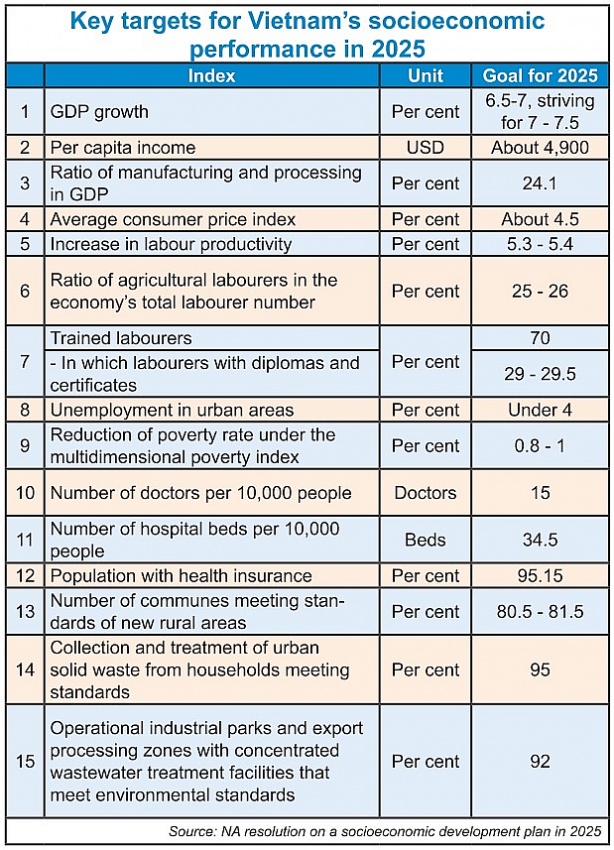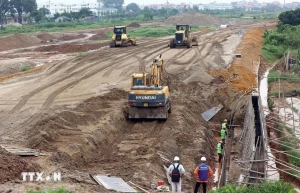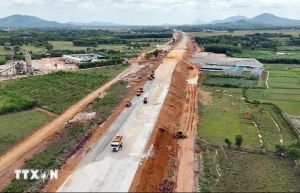Slow disbursement hinders ambitions
Last week, the National Assembly (NA) approved a resolution on Vietnam’s socioeconomic development plan for 2025. The plan was shaped by extensive discussions among lawmakers, reflecting the country’s current economic landscape and anticipated developments, both domestically and internationally.
A central concern remains the impact of global geopolitical tensions on Vietnam’s economic stability, which may challenge efforts to achieve the nation’s ambitious goals.
The resolution sets a cautious GDP growth target of 6.5-7 per cent, with aspirations to reach 7-7.5 per cent – a slight increase over this year’s expected growth of 6.8-7 per cent. Per capita income is projected to rise to around $4,900, up from an estimated $4,647 in 2024, while the contribution of manufacturing and processing to GDP will remain steady at 24.1 per cent.
In its report to the NA, the government outlined its main priorities for 2025, focusing on “boosting economic growth based on maintaining macroeconomic stability; controlling inflation; and ensuring the country’s key economic balances”. Additional goals include ongoing institutional reforms, infrastructure development, improvements in human resource quality, and fostering science, technology, and innovation.
 |
Increasing public investment
To achieve its ambitious economic targets, the government has placed strong emphasis on accelerating public investment disbursement from the beginning of the year, especially for programmes, projects, and works of national significance that promote provincial, regional, and international connectivity. Public investment is viewed as a critical catalyst for mobilising additional capital for national development.
Prime Minister Pham Minh Chinh has issued a public directive urging swift measures to expedite public investment disbursement in the final months of 2024. The directive was addressed to ministers, local government leaders, and NA delegations across the country.
Despite these efforts, the Ministry of Finance has reported that public investment disbursement reached only 52.3 per cent of the initial target in the first 10 months of 2024, lower than the 56.74 per cent recorded in the same period last year. This figure is well below the government’s expectations, prompting further concerns about the pace of economic recovery.
Certain ministries and agencies have reported especially low disbursement rates. For example, the Vietnam Cooperative Alliance reported zero disbursement, while the Vietnam Fatherland Front Central Committee reported just 1.35 per cent. Several provinces also demonstrated low disbursement rates, with Ho Chi Minh City reporting only 19.63 per cent and Phu Yen at 24.63 per cent.
Deputy Minister of Planning and Investment Tran Quoc Phuong noted, “As stipulated in the Law on State Budget, we have only three months left to boost public investment disbursement and reach the disbursement target.” The total public investment allocated for 2024, including funds carried over from previous years, is nearly $32.3 billion. The government has set a disbursement target of at least 95 per cent for 2024.
Phuong attributed the slow disbursement rate to various challenges, with the primary issue being a shortage of materials for large-scale projects, particularly for roads and expressways. He explained, “Addressing this material shortage involves not only the Law on Public Investment but also other laws, especially those governing minerals and licensing for the mining and trading of materials used in projects. Furthermore, procedural hurdles related to project adjustments have also created challenges.”
Next year, the government aims to advance and complete a number of key infrastructure projects, including upgrading and expanding major expressways and bringing new facilities into operation at key airports. The completion of Terminal 3 at Tan Son Nhat International Airport in Ho Chi Minh City, Terminal 2 at Noi Bai International in Hanoi, and major projects for the future Long Thanh International Airport in Dong Nai are all on the agenda.
Additionally, the government is committed to achieving 3,000 kilometres of expressways, with plans to start construction on the Lao Cai-Hanoi-Haiphong railway. Investment procedures for the high-speed North-South railway, a project with an estimated initial cost of $67.34 billion, are expected to be finalised by 2025.
Continued administrative reform
In addition to selectively attracting foreign direct investment (FDI), the government is actively working to streamline administrative procedures, aiming to build an efficient and effective governance structure. Power decentralisation is also a priority, ensuring resource allocation aligns with local needs. Vietnam is determined to eliminate the often-cited “ask-give” mechanism, which describes a system in which officials’ actions depend on receiving approval from superiors, often with an exchange of favours.
The 2018 Law on Supporting Small- and Medium-sized Enterprises provides the national framework for policies supporting innovative firms and startups, but its implementation has been limited.
While the government has introduced policies to support such enterprises in areas such as taxation, access to finance, innovation, and value chain development, programme budgets remain small, and uptake of these programmes has been low, according to the Organisation for Economic Co-operation and Development.
Additionally, some aspects of the law have not been fully enforced. For example, Article 18 offers tax exemptions and reductions for investors, but the implementation of this article has been hampered by the lack of detailed corporate income tax regulations, according to the World Bank.
 | Hanoi keeps hastening investment attraction, disbursement Hanoi recorded encouraging results in investment attraction and disbursement during the first half of 2024, and is poised to push ahead with this work in the coming time. |
 | PM urges speeding up disbursement of public investment Prime Minister Pham Minh Chinh on October 8 signed an official dispatch, urging relevant authorities to accelerate the disbursement of public investment in the remaining months of this year. |
What the stars mean:
★ Poor ★ ★ Promising ★★★ Good ★★★★ Very good ★★★★★ Exceptional
Related Contents
Latest News
More News
- Global partnerships key to Vietnam’s IFC development (December 26, 2025 | 16:18)
- Vingroup pulls out of bid to invest in North-South high-speed railway (December 26, 2025 | 11:42)
- Strengthening supply chains through trade promotions and customs reform (December 24, 2025 | 14:00)
- PM orders investment model for North–South high-speed rail (December 22, 2025 | 17:43)
- LS Eco Energy to invest in Vietnam rare earth sector (December 22, 2025 | 17:31)
- Government moves to establish International Financial Centre (December 21, 2025 | 21:00)
- Vietnam's IFC to target global investment flows (December 21, 2025 | 18:00)
- Two national hospitals expand capacity with new facilities (December 20, 2025 | 09:00)
- Ha Tinh breaks ground on major Vingroup industrial and energy projects (December 19, 2025 | 18:24)
- EVN launches major power infrastructure projects nationwide (December 19, 2025 | 18:17)

 Tag:
Tag:





















 Mobile Version
Mobile Version